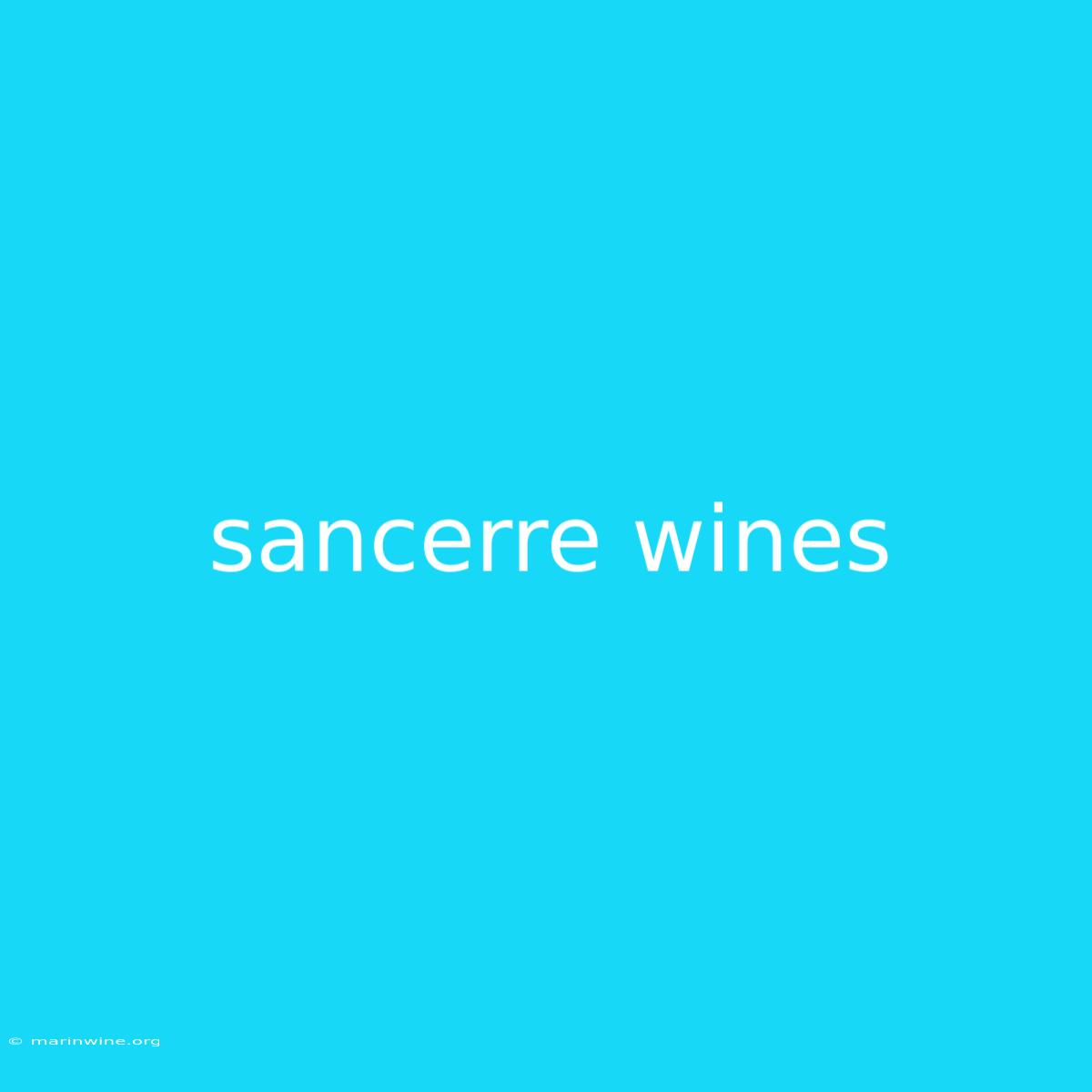Unlocking the Secrets of Sancerre Wines: A Journey Through the Loire Valley
Have you ever wondered what makes Sancerre wines so special? These crisp and elegant wines, hailing from the Loire Valley in France, are known for their unique character and refreshing taste. Let's embark on a journey to explore the captivating world of Sancerre wines.
Why Sancerre Wines Matter
Sancerre wines are more than just a delicious drink. They represent a rich history of winemaking, a unique terroir, and a commitment to quality. The region is renowned for its Sauvignon Blanc grapes, which produce wines with vibrant acidity, distinct aromas, and a lingering finish. Understanding the characteristics of Sancerre wines allows you to appreciate their complexity and enjoy them to the fullest.
Key Takeaways of Sancerre Wines:
| Feature | Description |
|---|---|
| Grape Variety: | Primarily Sauvignon Blanc (99%), with a small percentage of Pinot Noir |
| Terroir: | A diverse landscape of chalky, flinty soils, and limestone cliffs |
| Climate: | Temperate climate with warm summers and cool winters |
| Style: | Dry, crisp, and refreshing, with aromas of citrus, green apple, flint, and gooseberry |
| Food Pairing: | Excellent with seafood, goat cheese, salads, and light dishes |
Sancerre Wines: A Detailed Exploration
Sauvignon Blanc: The Heart of Sancerre
The Sauvignon Blanc grape is the cornerstone of Sancerre winemaking. Its adaptability to the diverse terroir of the region produces wines with distinct characteristics.
Key Facets of Sauvignon Blanc in Sancerre:
- Acidity: The high acidity gives Sancerre wines their crispness and refreshing quality.
- Aromas: Flavors vary from grassy and herbal to citrusy and mineral. The soil type strongly influences the aroma profile.
- Body: Sancerre Sauvignon Blancs are generally light-bodied, making them perfect for enjoying chilled.
- Aging Potential: While many Sancerre wines are meant to be enjoyed young, some producers create wines with aging potential, developing complex notes of honey and toast.
The Role of Terroir
The unique terroir of Sancerre plays a crucial role in shaping the character of its wines. The combination of soil type, climate, and vineyard location influences the flavor profile and structure of the grapes.
Key Facets of Sancerre Terroir:
- Chalky Soils: The region's chalky soils provide excellent drainage and contribute to the high acidity of the grapes.
- Flinty Soils: Sancerre wines often exhibit a characteristic flintiness, attributed to the presence of flint in the soil.
- Limestone Cliffs: The limestone cliffs around Sancerre add a mineral complexity to the wines.
Exploring the Diversity of Sancerre Wines
While Sauvignon Blanc reigns supreme in Sancerre, there's more to discover.
Key Facets of Sancerre Diversity:
- Dry Red Wines: A small amount of Pinot Noir is produced in Sancerre, resulting in light-bodied, red wines with delicate flavors.
- Rose Wines: Sancerre rosé, made from Pinot Noir grapes, offers a fresh and fruity alternative to Sauvignon Blanc.
- Vintage Variations: Each vintage presents a unique character, reflecting the weather conditions of the year.
Sancerre: A Wine Region for Every Palate
The beauty of Sancerre wines lies in their diversity. Whether you prefer crisp and vibrant Sauvignon Blancs, complex aged wines, or the delicate nuances of Pinot Noir, there's a Sancerre wine waiting to be discovered.
FAQ for Sancerre Wines
Q: How can I tell if a Sancerre wine is good?
A: Look for wines from reputable producers and check for the appellation "Sancerre" on the label.
Q: Are Sancerre wines expensive?
A: Sancerre wines offer a range of price points, from affordable to premium, reflecting the quality and age of the wine.
Q: How should I serve Sancerre wines?
A: Serve Sauvignon Blanc chilled at around 45-50 degrees Fahrenheit (7-10 degrees Celsius).
Q: What are some recommended Sancerre wines?
A: Seek out producers like Pascal Cotat, Domaine Vacheron, and Domaine Henri Bourgeois, known for their high-quality wines.
Tips for Enjoying Sancerre Wines:
- Explore different producers: Sample wines from various producers to discover your preferred style.
- Pair with fresh flavors: Sancerre wines complement seafood, salads, goat cheese, and light dishes.
- Consider vintage variations: Seek out older vintages for complex flavors or enjoy young wines for vibrant fruitiness.
- Store properly: Store unopened bottles of Sancerre in a cool, dark place.
- Serve chilled: Enjoy the full flavor of Sauvignon Blanc by serving it chilled.
Summary by Sancerre Wines:
This exploration of Sancerre wines has highlighted the key factors contributing to their unique character and appeal. From the Sauvignon Blanc grape to the diverse terroir and the meticulous winemaking practices, each element plays a crucial role in creating these delightful wines. Whether you are a seasoned wine enthusiast or a curious newcomer, Sancerre offers a fascinating journey of taste and discovery.
Closing Message:
Embrace the elegance and crispness of Sancerre wines, and discover a world of flavor waiting to be explored.

